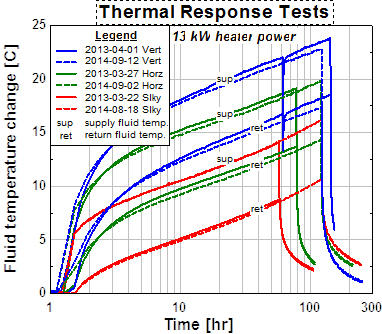NZERTF Short-Term Tests
Short-Term Tests Conducted Between July 2014 - September, 2014

- A second round of Thermal Response Tests was carried out on the three earth-coupled heat exchangers surrounding the house. The tests were carried out approximately 18 months after the initial tests, which occurred shortly after construction of the NZERTF was completed. During the tests, each of the vertical u-tube, horizontal u-tube, and horizontal slinky heat exchangers were subjected to a 13 kW heat input to the antifreeze circulating through the buried tubing. The heat input approximates the load that would occur at peak loading for a heat pump in the summer. The temperature changes of the fluid entering and exiting the heater section (referred to as the "supply" and "return" temperatures) were monitored, and are shown in the graph for both sets of tests for all three heat exchangers. For each heat exchanger, the temperature change is very similar between the tests carried out with 18 months separation, indicating that the thermal performance has not significantly changed since construction or from season to season.

- Tracer gas decay tests under various conditions were performed in order to more accurately characterize the amount of outdoor air supplied to the house through the HRV (mechanical ventilation) and through the building envelope (infiltration). Tests were performed in July 2014 and August 2014 under normal operating conditions, elevated indoor temperatures, and with the HRV on and off. During these various conditions, additional air samples were taken to compare the relative impact of the conditions on measured volatile organic chemical (VOC) concentrations.
Created December 3, 2014, Updated August 25, 2016

